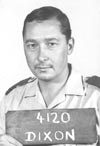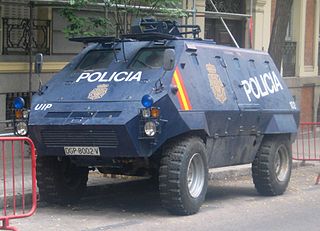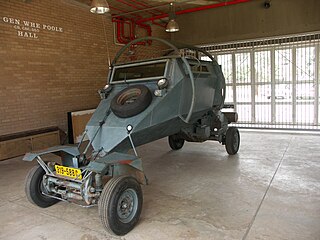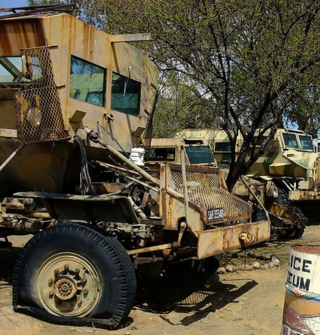Related Research Articles

The Rhodesian Bush War, also called the Second Chimurenga as well as the Zimbabwean War of Liberation, was a civil conflict from July 1964 to December 1979 in the unrecognised country of Rhodesia.

Squadron Leader Christopher John Taylor Dixon D.C.D., also known by his callsign of Green Leader, was a Rhodesian military pilot for the Rhodesian Air Force and was born in Shabani, Southern Rhodesia. He was best known for leading the Rhodesian Operation Gatling bombing raid over Zambia, which later became known as the "Green Leader Raid".

The Thyssen Henschel UR-416 is a German armoured personnel carrier, first introduced in 1969 and based on the body of the Mercedes-Benz Unimog light truck.

The Rhodesian Armoured Corps, nicknamed the "Black Devils" — was the only standing armoured battalion of the Rhodesian Security Forces. During World War II, it took part in the Allied Spring 1945 offensive and the Battle of Monte Cassino as part of South Africa's 6th Armoured Division. The unit was among the first to enter a liberated Florence in July 1944. Prior to 1963, its crews were trained in the United Kingdom or Aden Colony and were known as the "Selous Scouts" under the Federation of Rhodesia and Nyasaland. After Rhodesia's Unilateral Declaration of Independence, maintaining the armoured vehicle fleet became a responsibility of the Rhodesian Light Infantry until Major Bruce Rooken-Smith reactivated the former Rhodesian Armoured Car Regiment in 1972. During the Rhodesian Bush War, the regiment fought in several major campaigns and battles, particularly Operation Miracle in September 1979. It was superseded by the new Zimbabwe Armoured Corps between 1980 and 1981.

The Rhodesian Security Forces were the military and security forces of the Rhodesian government. The Rhodesian Security Forces consisted of a ground force, the Rhodesian Air Force, the British South Africa Police, and various personnel affiliated to the Rhodesian Ministry of Internal Affairs. Despite the impact of economic and diplomatic sanctions, Rhodesia was able to develop and maintain a potent and professional military capability.

Air Rhodesia Flight 825 was a scheduled passenger flight that was shot down by the Zimbabwe People's Revolutionary Army (ZIPRA) on 3 September 1978, during the Rhodesian Bush War. The aircraft involved, a Vickers Viscount named the Hunyani, was flying the last leg of Air Rhodesia's regular scheduled service from Victoria Falls to the capital Salisbury, via the resort town of Kariba.

The Pookie MRAP vehicle was created to deal with the constant mining of roadways during the Rhodesian Bush War.

The Leopard Security Vehicle is an unusual land-mine protected APC used by the Rhodesian Government and civilian population during the 1964-1979 Rhodesian Bush War. It offered basic but necessary protection against mine attack through the use of a V-hull.
The Gazelle FRV or Fast Reconnaissance Vehicle is a 4×4 infantry fighting vehicle (IFV) built for reconnaissance on the chassis of the Mercedes-Benz Unimog light truck developed by Zimbabwe in the early 1980s.

The Mine Protected Combat Vehicle – MPCV was a Rhodesian 4×4 Infantry fighting vehicle (IFV), first introduced in 1979 and based on the body of the Mercedes-Benz Unimog light truck. It remains in use with the Zimbabwe National Army.
The Crocodile Armoured Personnel Carrier or "Croc" is a Rhodesian armoured personnel carrier first introduced in 1977 and based on Japanese commercial trucks' chassis. It remains in use with the Zimbabwe National Army (ZNA).
The MAP75 Armoured Personnel Carrier is a Rhodesian 4x4 heavy troop-carrying vehicle (TCV) first introduced in 1978 based on a Mercedes-Benz truck chassis. It remains in use with the Zimbabwe National Army.
The MAP45 Armoured Personnel Carrier is a Rhodesian/Zimbabwean 4x4d heavy troop-carrying vehicle (TCV) first introduced in 1978 based on a Mercedes-Benz truck chassis. It remains in use with the Zimbabwe National Army.
Operation Eland, also known as the Nyadzonya Raid, was a military operation carried out by the Rhodesian Selous Scouts at Nyadzonya in Mozambique on 9 August 1976. The Rhodesians initially claimed that 300 ZANLA and 30 FAM soldiers were killed, but later claimed that documentation captured after the event suggested that more than 1,028 were killed. ZANLA and Amnesty International claimed that the people killed were unarmed refugees.
The 1981 Entumbane uprising, also known as the Battle of Bulawayo or Entumbane II, occurred between 8 and 12 February 1981 in and around Bulawayo, Zimbabwe amid political tensions in the newly independent state. Zimbabwe People's Revolutionary Army (ZIPRA) guerrillas, mainly in the city's western suburb of Entumbane, rebelled, creating a situation that threatened to develop into a fresh civil war, barely a year after the end of the Bush War. The Rhodesian African Rifles (RAR) and other white-commanded elements of the former Rhodesian Security Forces, fighting for the Zimbabwean government as part of the new Zimbabwe National Army, put down the uprising. Groups of Zimbabwe African National Liberation Army (ZANLA) fighters attacked both ZIPRA and the government forces during the revolt, which followed a smaller outbreak of fighting between guerrillas in November 1980.

Operation Miracle or the Battle of Mavonde was a military raid in 1979 by the Rhodesian Security Forces (RSF) against ZANLA guerrilla bases in Mozambique towards the end of the Rhodesian Bush War. ZANLA put up stiff resistance and the tactical success of the RSF did not lead to the expected strategic changes.

The Hippo is a South African armoured personnel carrier. Specially designed to be mine resistant, it can carry ten infantrymen and a crew of two. The vehicle's remote-operated turret mounts dual 7.62mm machine guns, but like other improvised fighting vehicles, it is only lightly protected against ballistic threats.
Operation Vanity was a Rhodesian military operation in Angola with clandestine assistance from the South African Air Force (SAAF) during the Rhodesian Bush War. The Rhodesian Air Force planned a retaliatory raid against a ZIPRA camp in Angola after a second Air Rhodesia Viscount was shot down on 12 February 1979.
The Rhodesian Defence Regiment (RDR) was a unit of the Rhodesian Army during the last years of the Rhodesian Bush War from 1978 to 1980. It was a guard unit composed of mainly coloured and Asian conscripts.
Operation Snoopy was an operation launched by Rhodesia in response to Air Rhodesia Flight 825 being shot down by a communist backed insurgent group, the ZIPRA. The operation took place in Mozambique, where many of the ZANLA's camps were located, particularly in the area in and around Chimoio.
References
- Laurent Touchard, Guerre dans le bush! Les blindés de l'Armée rhodésienne au combat (1964-1979), Batailles & Blindés Magazine No. 72, April–May 2016, Caraktère, Aix-en-Provence, pp. 64–75. ISSN 1765-0828 (in French)
- Paul L. Moorcraft & Peter McLaughlin, The Rhodesian War: A Military History, Pen and Sword Books, Barnsley 1983 (2008 ed.). ISBN 978-1-84415-694-8
- Peter Abbott, Philip Botham & Mike Chappell, Modern African Wars (1): Rhodesia 1965–80, Men-at-arms series 183, Osprey Publishing Ltd, London 1986. ISBN 9780850457285
- Peter Gerard Locke & Peter David Farquharson Cooke, Fighting Vehicles and Weapons of Rhodesia 1965-80, P&P Publishing, Wellington 1995. ISBN 0-473-02413-6
- Peter Stiff, Taming the Landmine, Galago Publishing Pty Ltd., Alberton (South Africa) 1986. ISBN 9780947020040
- Robert K. Brown, The Black Devils, Soldier of Fortune Magazine, January 1979, Omega Group Ltd., Boulder, Colorado.